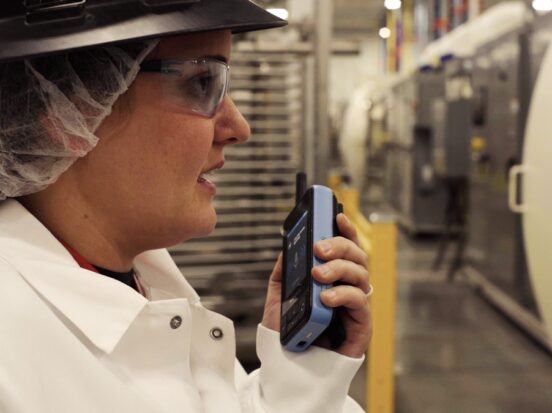At the turn of the 21st century, the Internet of Things (IoT) promised to make it easier for companies to automate processes on the frontlines. This framework has given rise to “smart” devices, and different industries have used this to their advantage.
Now, a similar concept is emerging called the Internet of Workers (IoW). Rather than merely connecting objects and gadgets in order to automate processes, IoW prioritizes the safety and productivity of the person using the technology. When you understand the Internet of Things definition and the differences between IoT and IoW, you’ll be able to select the right solutions for your frontline team.
Key takeaways:
- While IoT devices collect data and automate tasks from machines, IoW devices are designed to support the needs of frontline workers.
- The Internet of Workers enhances worker safety and productivity with technology like smart industrial radios. Contrast this with the Internet of Things, which primarily automates processes.
- The Walt Smart Radio by weavix is the world’s first IoW platform, offering improved communication, resource management, and data processing to boost worker safety and productivity.
What is the Internet of Things (IoT)?
The Internet of Things is a system of connected devices and machinery that collect and share data. These industrial devices can monitor equipment performance in ways that would otherwise require regular intervention from frontline workers.
IoT examples include:
- Recording unusual sounds and vibrations which might indicate potential equipment failure
- Tracking the temperature of machine components throughout their lifecycle
- Scheduling maintenance and ordering replacement parts based on machinery usage patterns
While all of these tasks have the potential to be performed more efficiently through the use of IoT technology, they can’t happen without human interaction. Frontline workers are excellent at connecting contextual clues to the big picture, something which industrial sensors are not designed to do. Only by joining forces can workers help IoT realize its full potential, and vice versa. This realization led directly to the development of IoW systems.
Industrial Internet of Things Definition
Industrial Internet of Things (IIoT) is the application of IoT technologies in manufacturing, energy, logistics, and other industrial operations. IIoT was originally hailed as an essential element of digital transformation in the Factory of the Future and Industry 4.0. However, a number of factors — independent of the human connection — have significantly slowed the adoption of these technologies.
Key Challenges of Industrial IoT
- High investment costs: Implementing solutions for the Industrial Internet of Things requires substantial upfront investments in hardware, software, and infrastructure
- Integration complexities: Many industrial facilities struggle with IIoT integration, with legacy equipment and existing systems serving as major obstacles
- Cybersecurity risks: Connecting previously isolated operational technology (OT) systems to the internet expands the attack surface, making industrial systems more vulnerable to cyber threats
- Interoperability issues: A lack of universal standards combined with a vast ecosystem of proprietary solutions creates difficulties in connect devices from different vendors
- Skills gap: There are not enough professionals with the necessary experience to design, deploy, and maintain IIoT systems
Additional Hurdles of IIoT
- Data management: IIoT devices can generate very high quantities of data, which can potentially overwhelm traditional data management systems
- Connectivity problems: Reliable network coverage and sufficient capacity are crucial for IIoT implementation but not always available
- Scalability concerns: Siloed legacy systems can create significant obstacles to implementing IIoT technologies throughout a company’s operations
Despite these challenges, IIoT continues to evolve, and some industries are making progress in overcoming these obstacles. However, the technology has not yet reached the transformative impact initially anticipated in many industrial settings.
Keep reading: Understand why the Internet of Things only runs with workers
What is the Internet of Workers (IoW)?
The Internet of Workers describes devices and systems whose functions, while similar to IIoT technologies, are instead focused on the needs and safety of frontline workers. The weavix IoW platform is the first of its kind, offering a complete suite of communication solutions and productivity analytics for frontline workers across manufacturing, construction, food and beverage, and beyond.
The goals of IoW are twofold:
- Equip workers with low-cost computing devices so they can stay safe while improving their productivity
- Furnish enterprises with the tools they need to manage and optimize their workforce more effectively
By tying IoT data to the worker, enterprises can determine the best ways for that data to be used to improve worker safety and increase revenue.
Learn more about how we define IoW in this episode of The Thread with our Chief Strategy Officer, Blake Carlson:
IoW vs. IoT Devices: Key Differences
As we mentioned earlier, frontline workers can help IIoT technologies reach their full potential, just as IIoT devices can help workers perform their jobs more safely and efficiently.
However, many companies struggle with IoT device adoption because frontline workers believe the devices will either automate them out of a job or continuously track them.
In contrast, IoW systems are designed to enable frontline workers by improving collaboration, increasing productivity, and creating more engaged teams. Simply put, IoW systems are the bridge between IIoT devices and frontline workers. As we keep this in mind, it’s important to understand the key differences between IoW and IoT-focused systems.
| weavix Internet of Workers Device | Internet of Things Devices | |
|---|---|---|
| Purpose | Use low-cost compute on a ruggedized wearable device to improve worker safety & productivity, while giving enterprises the insights they need to manage & optimize their workforce | Use low-cost compute on physical devices and equipment to automate processes and monitor performance, enabling enterprises to collect and analyze operational data |
| Technologies |
|
|
| Top Features |
|
|
| Industries That Benefit From This Device |
|
|
Benefits of IoT in Industry
Despite the fact that industrial IoT systems often involve costly, complex integration challenges, they have the potential to transform manufacturing processes when implemented correctly.
Key Benefits of IIoT:
- Equipment Monitoring: IIoT sensors can track temperature fluctuations or strange vibrations in machinery. This allows your maintenance team to stay on top of repairs and potentially prolong the life of the systems. It can also help eliminate costly production delays.
- Predictive Maintenance: Finding patterns in machine performance by manual logging is time-intensive and unreliable. IIoT sensors can potentially reduce maintenance or replacement costs, though this often requires a major upfront investment to extend a machine’s lifecycle.
- QA Automation: Product specifications can be monitored during the manufacturing process. For example, in pharmaceuticals or life sciences, products which don’t meet certain weight or chemical composition criteria can be flagged and efficiently discarded.
- Energy Management: Smart meters can be used to help keep energy costs under control or even to find issues with machines. Industrial companies often include IIoT devices in their strategic energy management plans (SEM).
- Environmental Monitoring Inside Factories: Connected sensors can track air quality for humidity or toxins.
Benefits of IoW in Industry
Your workers are the most important part of your facility, and IoW gives them the tools they need to boost productivity and minimize safety risks. The Internet of Workers extends the promise and potential of IoT to frontline workers through smart industrial radios.
Key Benefits of IoW:
- Enhanced Safety: Teams can immediately respond to potential hazards and emergency situations thanks to real-time communication and alert systems.
- Improved Collaboration: Smart industrial radios can remove language barriers and erase distance limitations, which means workers can connect with each other no matter where they’re located.
- Data-Driven Decision Making: IoW allows enterprises to collect and analyze workforce activity data, so leadership teams can make informed decisions about training needs, resource allocation, and process improvements.
- Increased Productivity: Human-centric tech can help workers with their work routines and workflows, improving communications and reducing errors and distractions.
Keep reading: Learn how to choose the right smart radio
Which is Better for my Business: IoW or IoT Devices?
While IoT technologies prioritize automation and the health of machinery, IoW is focused on the worker who carries a device with them throughout their shift. This makes smart industrial radios perfect for the mobile or deskless workforce.
For example, it’s becoming common practice to add IoT sensors to assets throughout an industrial facility. Currently, when IIoT sensors go off due to a malfunction or low supply, a worker is responsible for the repairs. IoW emphasizes the need for technology that will allow the workers to stay connected to each other and, in the not-too-distant future, even see information on the device related to different machines in the facility.
IoT devices are used specifically to promote automation and collect data from machinery in the workplace, which means they are often blind to unique aspects of your employees’ workflow. The IoW acts on a more practical scale, allowing workers to collaborate on solutions in real-time. IoW also lets enterprises examine the business from the point of view of its employees, who are often underserved.
By enabling your employees with better digital tools, you can improve worker safety and productivity while they’re on the job.
Keep reading: Understand how technology adoption benefits frontline workers
Drive Innovation with Advanced IoW Technologies from weavix
For long-term success, it’s important for enterprises to gain as much context and visibility from their workforce as possible, namely through IoW. Though the Internet of Things has the potential to make a positive and lasting impact, it is often a misunderstood or overpromised technology. On the other hand, advancing your frontline with IoW platforms, such as the Walt Smart Radio System by weavix has the potential to take your operations to the next level.
Interested in learning more about what the Internet of Workers™ platform can do for your enterprise? Schedule a demo here.
 Payton Kolbeck
Payton Kolbeck 
